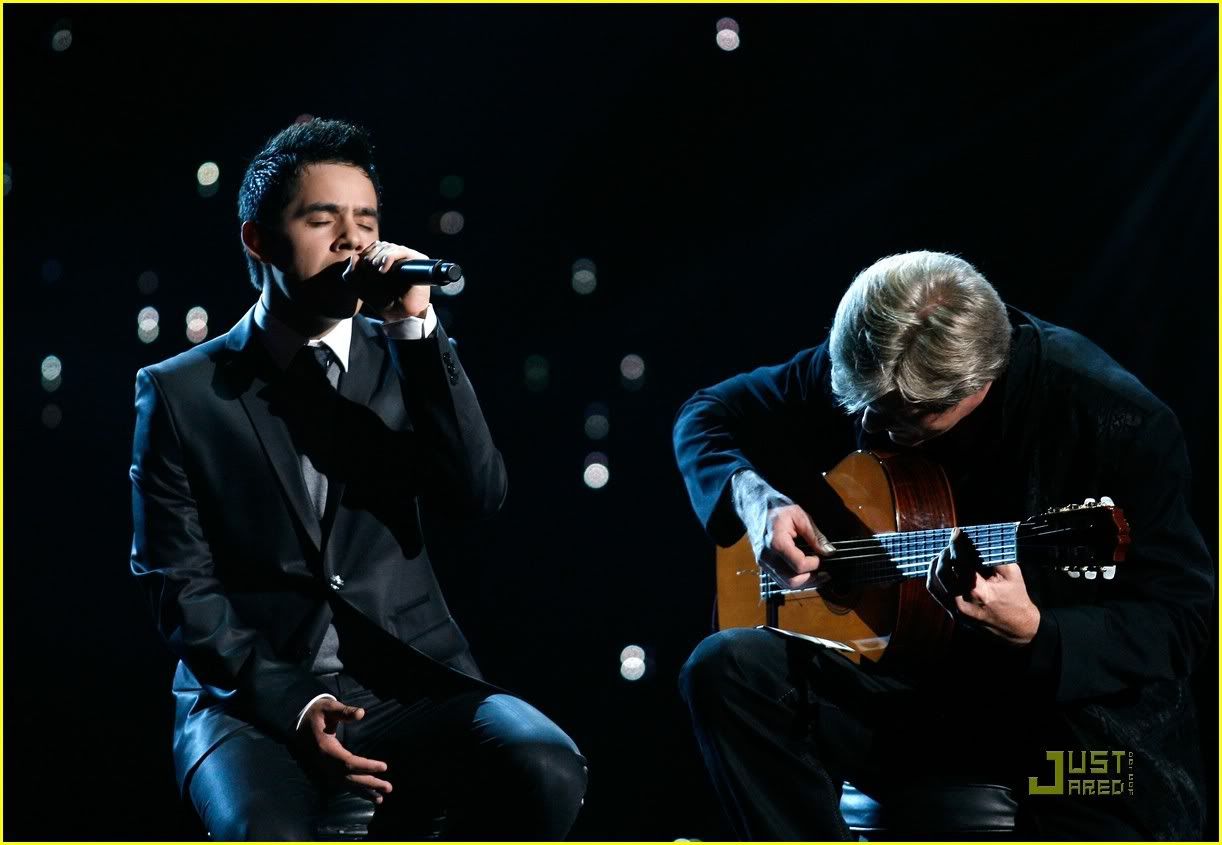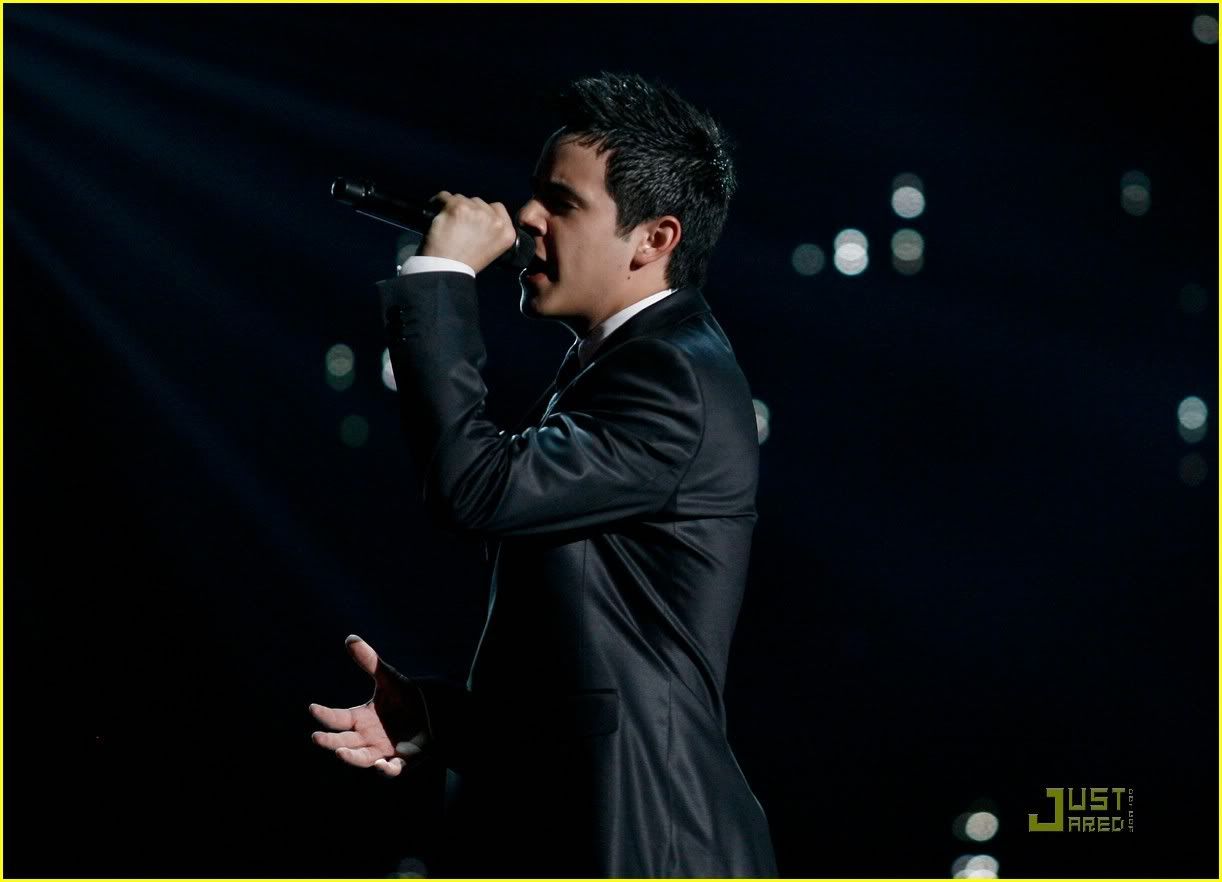Ronald粉絲對於大衛這次演唱的分析可說是目前最最深入的一篇力作,雖然非常長,但是對歌唱有興趣的人應該要耐心看完。為了幫助大家閱讀起見,我把第一段的大綱簡單的列在下面:
#大衛的演唱技巧讓他能夠去蕪存菁,讓歌的內在意義完全呈現,最後剩下來的就是最原始的聲音和情感(看的我都起雞皮疙瘩,因為這不就是我們聽他的歌百聽不厭的原因嗎)
#雖然簡單是大衛恪守的歌唱原則,但是他充滿愛意的關注每一個細節,把聆聽這首歌變成了最性感的經驗,最後的成果是如此有魅力,如此有力,讓完全不懂西班牙文的人彷彿也能了解他唱的每一個字(拍案叫絕!!這正是我的感受!)



請到繼續閱讀後去看完全文。
As David begins, we see that he has chosen to strip down the arrangement to only an acoustic guitar, exposing his voice to the most exacting scrutiny—every waver, every imperfection is on display for all to hear. Many accomplished singers often surround their voices with lush arrangements and do not make this choice. But David does.
David having made this decision, we are drawn from the beginning to focus only on his voice. With the guitar’s notes being played ever so softly, the song might as well be acappella. And his singing is rich and detailed: David is changing the tonal quality of his notes, fading away at the end of every line ever so softly. We are beckoned in to listen to every detail of his voice.
For nearly all other singers, the “events” are the high notes, the loud notes, the long melismas. But David does what virtually no singer does: make an event out of softness, gentleness, a near silence.
As David ends his intro, his voice subtly softens, and he slows down the song through ritardando (”junto a mi…”). He will do this again later (his last “amada mía”). We are left hanging—one thinks of a lover taking a breath before professing his love. David is in complete command—deciding when the song will speed up or slow down—and has us, the audience, in the palm of his hand. And in the very last words of the song, there is no more meter and we are simply left waiting for every word.
 As
the guitar provides a steady rhythm, David is phrasing the words in
such a way that they do not form simple patterns around the beats, but
instead bend and swerve around them. It all flows very naturally, is as
if he were speaking sentences over the music, sentences informed by his
deep musicality. David is also playing with rhythm, shortening
syllables here (”junto a miiii”), or extending notes to
lengths so long that they make us hold our breath (his first “en parte
de mi almaaaaa” extending to the very end of the musical measure). Just
as dancing to some forms of Latin music, with its syncopations and
complex rhythms, demands that one undulate and move in curves and
exhibit a rich sensuality, so does David express romance, with all of
its urgency and pain, through his phrasing.
As
the guitar provides a steady rhythm, David is phrasing the words in
such a way that they do not form simple patterns around the beats, but
instead bend and swerve around them. It all flows very naturally, is as
if he were speaking sentences over the music, sentences informed by his
deep musicality. David is also playing with rhythm, shortening
syllables here (”junto a miiii”), or extending notes to
lengths so long that they make us hold our breath (his first “en parte
de mi almaaaaa” extending to the very end of the musical measure). Just
as dancing to some forms of Latin music, with its syncopations and
complex rhythms, demands that one undulate and move in curves and
exhibit a rich sensuality, so does David express romance, with all of
its urgency and pain, through his phrasing.
There are places where David adds decoration to the melody (his second “en parte de me alma”). There are other places where David opts for outright simplicity just when one might expect ornamentation (singing the last syllable of his first “estrellas” in a single, extended note). A skillful writer varies his sentences and is not afraid of simplicity when this is the best way to express meaning. David constantly surprises, and the discerning listener does not quite know what will come next.
David gives a wispy quality to his voice through much of the first verse, at times singing in a near-whisper (”consuela”). He then makes us shudder the next moment with tremendous power (”es que has convertidoooo…”). David’s instrument is exceedingly expressive—it was put best by a fellow TDC’er (whose TDC name I do not know!) who commented as “Twilarchight” on YouTube: “He has a voice that can resonate across an entire concert venue without a microphone, yet has the a gift of caressing every syllable like it’s fragile crystal that will shatter upon contact.”
David makes sure to display the beauty of his mother’s native language. His consonants are exceedingly soft, and we are left almost entirely with a sequence of distinct vowels that are barely separated. In doing so, David draws out the Spanish language’s reliance on vowel patterns to distinguish various meanings. At times, we also hear the strength of the language’s rhythms in his forceful, almost staccato delivery (his first “en parte de mi alma”).
David also chooses to pronounce the “ll” in Spanish as a “zh” sound. (There are many Spanish speaking countries that speak a “y” sound.) Christina Aguilera does this as well, but David takes care to enunciate clearly every sound, so that when we hear it in certain lines (”no hay bella melodía”, “más allá de tus labios”) it has even more of a caressing, chocolate-melting-in-your-mouth quality.
David’s vocal production often goes through numerous transformations in a single line. Listening closely, one hears David changing the tonal quality and volume of his voice while in the middle of a word (“estrellaaaas”). Sometimes he alternates crescendo and diminuendo in a single phrase, sometimes even in a single syllable (”junto a miiiiiii”). David’s also varies his vibrato constantly—one hears him adding a little here, a little more there, and none of it in another place. (Compare the amount of nuance and variation in his vibrato alone compared to that in his AI performance of “Imagine,” and one sees a forward leap in musical sophistication and control.)
David’s attention to detail, this commitment to sensuousness, is paid off at the end of the first chorus when the audience breaks out in appreciative, rapturous applause. Singers often get ovations only at the end of the song or in the middle of a technically challenging note, but not here—David is getting recognition for an entire sequence in which he has demonstrated musical mastery, just as a musically inclined audience might react after hearing a brilliant extended jazz improvisation.
 The
appropriateness and grace that David often applies to melody is on full
display. This is partly because the original melody is so beautiful and
graceful, but one need only compare his second chorus to his first to
see that David is reimagining the melody, a la “Love Me Tender.” Nearly
every phrase in the second chorus is sung more urgently than in the
first. In addition to reinventing the original melody, he is
reinventing his own reinvention. What is more, he is also aware of the
overall shape of the melody, and the relationship between each part to
a whole—the ending of every line is a suitable basis for the beginning
of the next (the second time he sings “estrellas” he moves the note up
and back down again to build anticipation). And finally, stepping back,
there is a “shape” to the entire song: we never do we find ourselves
wondering “where is he going with this?” or “when is this song going to
end?”.
The
appropriateness and grace that David often applies to melody is on full
display. This is partly because the original melody is so beautiful and
graceful, but one need only compare his second chorus to his first to
see that David is reimagining the melody, a la “Love Me Tender.” Nearly
every phrase in the second chorus is sung more urgently than in the
first. In addition to reinventing the original melody, he is
reinventing his own reinvention. What is more, he is also aware of the
overall shape of the melody, and the relationship between each part to
a whole—the ending of every line is a suitable basis for the beginning
of the next (the second time he sings “estrellas” he moves the note up
and back down again to build anticipation). And finally, stepping back,
there is a “shape” to the entire song: we never do we find ourselves
wondering “where is he going with this?” or “when is this song going to
end?”.
In fact, the whole song is so beautiful that in the song’s last moments, when the song’s meter is gone, with David singing those last few notes ever so slowly, we are right there with him wishing we would never leave this peaceful place he has brought us.
Christina Aguilera’s version is the one that inspired David to love this song in the first place, and his interpretation resembles Christina’s quite closely. However, one can hear a difference in the runs—David’s usually have fewer notes, and sometimes one does not even know they are happening because they flow so naturally from the underlying melody (his second “si no estás tú también” is amazingly complex and diverges from the original shape of the melody, but one could easily not notice this). One who is not familiar with David might not notice that he is adding to the original melody. Furthermore, David is adding precious dynamics to his runs and is not simply alternating between notes: when he first sings “amada mía,” we hear him deepening and pressing with his voice to add emphasis (aptly giving it a more masculine feel while addressing a woman with the feminine ending “a”). Near the end of the song, when he sings “estoy” and glides back downward, he is constantly shifting the vowel syllable he is voicing and sliding from one note to the next, giving a different emphasis and sound to each one. At this moment, as he caresses every tone, one gets a feeling of the closest intimacy—of someone gently laying down his beloved. All of these dynamics invite one to enter the emotion of the song and drift to another place.
Luis Miguel’s version is very passionate and heartfelt, and he brings an awesome power to the big notes. When I listen to his interpretation, I think of “method acting,” in which an actor’s focus is on embodying a character and feeling his or her emotions, instead of using external techniques to communicate that emotion. Luis Miguel sings phrases the way one might when “singing from the gut” what one is feeling at one moment.
However, David seems to combine both passion and musicality: he “gets into” the song, but he also expresses this emotion through distinct musical choices. There is something very elegant about his melodic lines, so that they approach the grace of classical music. Luis Miguel’s version often used quickly spoken syllables followed by a long note, without much distinction between one phrase and the next or between the notes in each phrase. But just listen to the precise, jazzy movement of David’s second “más allá de tus labios”—set in a delicious, rhythmically-even pattern—which contrasts to the lines sung before and after it. And when he reaches the last syllable of “labios,” he inserts an extremely fast trill (alternating between two notes), increases in volume, decreases in volume, adds more vibrato, then increases in volume again while stepping to a higher note only to soften and slide down again, this time in an almost bluesy style. This is also David interacting with the guitarist, who changes rhythmically and strums a series of jazz chords in sequence. While some singers may demonstrate musical virtuosity by pulling from a toolbox of discrete tools—melisma, growling, purring, each method distinct from the other—David combines techniques, with a larger musical vocabulary, and within each technique uses a spectrum of variation.
 Having
lovingly painted an aural canvas and guided his audience to an
intimate, peaceful place, David finishes the song with what can only be
described as a cry to heaven (”estoy”). While Christina chose to
emphasize the high point of this song with ornamentation, David does
something different. He is going after the emotion, and is telling a
story through his singing. After already demonstrating how love makes
him feel, he is now showing how much he is willing to give and
sacrifice for it. It is as if every moment, every nuance in the song he
has added so far has prepared us for this one fearsome moment—a moment
awesome in its power and which David has fully earned. David, having
stripped away everything that was extraneous, has now taken us by the
hand and guided us to the center of the song and its secret. With
nothing left to take away—we now hear what he hears.
Having
lovingly painted an aural canvas and guided his audience to an
intimate, peaceful place, David finishes the song with what can only be
described as a cry to heaven (”estoy”). While Christina chose to
emphasize the high point of this song with ornamentation, David does
something different. He is going after the emotion, and is telling a
story through his singing. After already demonstrating how love makes
him feel, he is now showing how much he is willing to give and
sacrifice for it. It is as if every moment, every nuance in the song he
has added so far has prepared us for this one fearsome moment—a moment
awesome in its power and which David has fully earned. David, having
stripped away everything that was extraneous, has now taken us by the
hand and guided us to the center of the song and its secret. With
nothing left to take away—we now hear what he hears.
There comes a point when this analysis must end—while David approaches song deliberately, not all that he does is deliberate. He is not simply executing a predetermined plan, but is living in the music as he sings it. I am sure that some of the “choices” I have described were not actually “chosen.” I read somewhere (I believe it was something written by Chenson) that a lot of the beauty and subtlety David brings is subconscious, that he does much of this without thinking about it. In addition to what he plans beforehand, much of what he actually does, in the moment, flows from his deep musical instincts. Although David is a perfectionist, he does not try to achieve a perfection that is is stable and frozen—every time he performs he is seeking beauty and grace. This is perhaps David’s most important gift—at the end of the day, all the technical mastery and musical craftsmanship in the world cannot replace the fact that David loves every moment he is up on that stage—living in the music.
Some great artists have described how, after finishing their work, they are moved to tears. They feel they have given all they have, and that a piece of their soul rests within what they have created.
Every song holds cradled within it a part of the soul of its composer, a soul that resonates in the hearts of its listeners and singers long after they are gone. David has taken a song that is widely adored, placed a part of his soul within it, and shared it with the world. He has created what is now the definitive version of a widely-known, much-beloved song and made us see its beauty with new eyes. Again.
-Ronaldsf


 留言列表
留言列表

